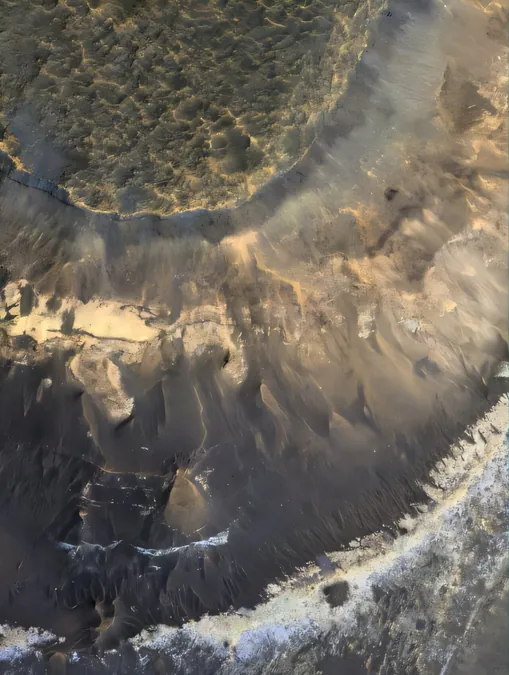
Unlocking Mars: Thick Clay Layers May Hold Keys to Ancient Life
2025-06-17
Author: Charlotte
Mars' Clay Layers: A Gateway to the Past
Mars, the intriguing red planet, is home to extensive layers of clay that extend hundreds of feet deep. These formations, which require water to form, have sparked the interest of scientists as they search for clues about ancient life.
The Waters of Time: Clay Formation Explained
A groundbreaking study published in Nature Astronomy by researchers from The University of Texas at Austin reveals that most of these clay terrains originated near ancient bodies of standing water, prevalent on Mars billions of years ago. This environment likely provided the ideal conditions for chemical weathering, resulting in rich clay deposits capable of nurturing early life.
Lead author Rhianna Moore emphasized the stability of these terrains, explaining, "These areas have abundant water but minimal elevation changes, creating a stable environment. Stability allows for the sustained conditions necessary for potential life to thrive longer."
A Unique Geological Legacy
Part of the study was conducted under UT's Center for Planetary Systems Habitability, focused on understanding life's origins beyond Earth. Rhianna Moore is now contributing to NASA's Artemis mission, proving that the quest for understanding extraterrestrial life continues.
Interestingly, these thick clay layers may also reveal insights into Mars’ ancient climate, particularly regarding its water and carbon cycles. Their formation hints at an imbalance that could explain the planet's scarcity of expected carbonate rocks.
Mars: A Wet World of the Past
Once, Mars was a lush planet, dotted with lakes and rivers that created the stunning geological features we observe today. The thick layers of clay tell a story of this moist epoch. Previously, not much was known about the specifics of their formation, nor how the surrounding terrain influenced their evolution.
In her analysis, Moore examined images from 150 clay deposits cataloged by NASA's Mars Reconnaissance Orbiter, studying their geography and proximity to ancient water features. Her findings indicate that these clays predominantly exist at lower elevations near former lake beds, rather than in areas with flowing water.
Earthly Comparisons: How Mars Measures Up
Co-author Tim Goudge, a professor at the Jackson School, noted intriguing parallels to Earth, stating, "On Earth, the thickest clay mineral sequences form in humid environments with minimal erosion. It appears that a similar balance exists on Mars, although the climates and geological processes differ significantly."
Tectonic Mysteries and Climate Shifts
The ancient Martian landscape was vastly different from Earth today. Earth's tectonic activity continually exposes new rocks, facilitating interactions with water and atmospheric CO2, crucial for climate regulation. Conversely, Mars, devoid of such movements, may have fostered a warmer, wetter environment when volcanic activity released CO2. This unique composition may have spurred clay formation.
Moreover, the lack of new surface rock hinders the chemical processes necessary for forming carbonate rock. Continuous clay formation potentially traps water and seizes essential chemical byproducts, preventing them from dispersing into the Martian geology.
A Missing Puzzle Piece in Martian Geology
Moore concluded, "This could be one of many factors explaining the puzzling absence of expected carbonates on Mars." As research continues, these thick clay layers may unravel more secrets about Mars' mysterious past and the possibility of ancient life.









 Brasil (PT)
Brasil (PT)
 Canada (EN)
Canada (EN)
 Chile (ES)
Chile (ES)
 Česko (CS)
Česko (CS)
 대한민국 (KO)
대한민국 (KO)
 España (ES)
España (ES)
 France (FR)
France (FR)
 Hong Kong (EN)
Hong Kong (EN)
 Italia (IT)
Italia (IT)
 日本 (JA)
日本 (JA)
 Magyarország (HU)
Magyarország (HU)
 Norge (NO)
Norge (NO)
 Polska (PL)
Polska (PL)
 Schweiz (DE)
Schweiz (DE)
 Singapore (EN)
Singapore (EN)
 Sverige (SV)
Sverige (SV)
 Suomi (FI)
Suomi (FI)
 Türkiye (TR)
Türkiye (TR)
 الإمارات العربية المتحدة (AR)
الإمارات العربية المتحدة (AR)